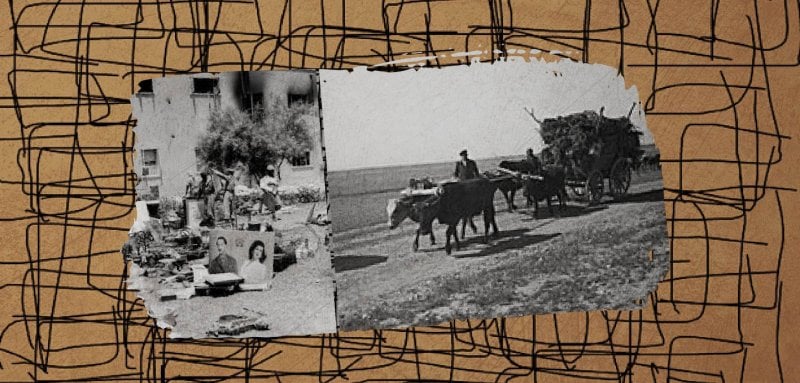In the town of Simele, 12 km away from the province of Dohuk, Iraq, the days from the 7th until the 11th of August 1933 were irregular days. Hordes of murder were ready to add another tragedy to the long list of tragedies that this stricken country has experienced. The story is not regular either since the murderer was the army of a newly born nation whose age has not exceeded 12 years old and the victims were the deep-rooted civilians of the country.
The town of Simele, who has experienced the tragedy, is part of a rich history, and its people, who established the Assyrian Empire that ruled the region 4.000 years ago and provided intellectual and material heritage to the country, one of the oldest populations in Mesopotamia.
The Assyrians consider themselves the followers of Saint Shimun Peter, one of Christ’s disciples, and date the age of their church to 33 AD. Unlike the rest of the churches, Assyrian people acknowledge the sanctity of Nestorius, the Archbishop of Constantinople who has always caused controversy between Christians denominations due to his teachings. Today, their church is led by the 122nd Patriarch Mar Awa Royel III and is located in Ankawa, a suburb of Erbil Governorate.
Historical tendencies
Syriac Nestorians have long demanded independence within the ancient Nineveh region that includes Nineveh and Dohuk provinces, some areas of Erbil, eastern Syria and southeastern Turkey, the fact that made them preys to constant violations. These violations started since ancient times until the Ottoman massacre led by Ahmet Reşit Rey in 1915 and the British occupation of Mosul in 1918, as stated by Joseph Yaacoub in his book “The repeated tragedy”.
From the very beginning, Britain resorted to recruit Assyrian people in a special brigade within the British crown known as the Assyrian Levies whose mission was, in the first place, to protect Assyrian cities. However, the British forces were led to shove them in the suppression of the Kurdish rebels and the Iraqi revolt of 1920, due to the turbulences that Iraq had experienced.
As stated in Zaid Adnan Naji’s work “Iraq's minorities during the Royal Era”, Assyrians hoped that their service to Britain would grant them the independence they were promised, according to some historical sources.
However, the unkept British promises to the Assyrian denomination led the Church of the East to address letters to the League of Nations in order to settle them in a semi-autonomous entity within French sponsorship in Syria between 1931 and 1932. In its turn, the French government refused.
The Church of the East did not stop its effort there and demanded the Iraqi government to recognize them as one of the many Iraqi creeds and to grant them a parliamentary seat that will represent them. However, at the time head of government Nuri Al-Said rejected the request because the Church of the East represented only a quarter of Mosul's Christian population.
According to the researcher in Iraqi political history Salam Al Azawy, “the rejection originated from the fear of both the Iraqi and the British government that the Assyrian’s independence would increase the ongoing Kurdish insurgencies in the country and the fear of France and Turkey for their interests in Syria”.
He added to Raseef22 that such repeated requests increased the intensity of political hostility against the Assyrians in Iraq especially that the government of Bagdad realized that the Assyrian autonomy won’t stop until the use of force.”
The beginning of the crisis
In the third part of his book “The history of the Iraqi Ministries”, the historical researcher Abd al-Razzaq al-Hasani mentions that the refusal that the Assyrian Church of the East and its Patriarch faced pushed Saint Shimun’s followers to submit mass resignations from the Assyrian Levies and to lead publicity campaigns supporting the Patriarch in the north of Iraq.
The former officer in the Assyrian Levies Malik Yaqo headed to Syria with 800 of his followers to convince the French Mandate to establish a semi-autonomous governance for them in east Syria. France rejected the idea and informed the government of Bagdad
The colonel in the British forces, Stafford, mentions that as a response, the government of Bagdad sent its military forces to Dohuk to scare and deter them and summoned Saint Shimun to Bagdad in order to negotiate. However, his insistence brought about his detention there, and later on, his exile in Cyprus.
According to the same author, the former officer in the Assyrian Levies Malik Yaqo headed to Syria along with 800 of his followers to convince the French Mandate to establish a semi-autonomous governance for them in the east of Syria. Despite that, France rejected again and informed the government of Bagdad about his return through Dayrabun crossing, between the two countries.
Prelude to the massacres
At Dayrabun crossing, the Iraqi Army got ready to arrest Yaqo. The first clashes between the army and the Assyrian forces took place on August 4th, 1933, during which the army suffered heavy losses and was forced to retreat towards Dayrabun village.
Historians disagree in determining who initiated this clash as well as on the source of the fighters’ weapon especially that the French forces confiscated their weapons after the meeting that had brought the parties together.
According to the researcher in the contemporary historical studies Ammar Al-Subaihawi, there are beliefs that the Assyrian fighters got their weapons back from the French forces, but they had prepared for the possibility of them being confiscated and hid numbers of weapon inside Assyrian villages in eastern Syria.
Speaking to Raseef22, the researcher justified his opinion saying that the ferocity of the clashes in which the two parties fought proves that the Assyrians possessed a large number of weapon that made it possible to defeat the government forces equipped with artillery.
According to Stafford, the Iraqi government assigned the military commander Bakr Sidqi to lead the military operation and rescue the government forces. Sidqi requested support to force Yaqo’s followers to yield and elements of the army chased Assyrian fighters in Mosul northwest mountains. Sidqi’s operations were known as bloody due to his assassination of every militant or civilian caught in the mountains.
Mass execution
Bakr Sidqi relocated his troops to Alqosh village and asked all the Assyrians in the city to hand their weapons over and to seek refuge in the police stations in order to put the rebellions down. The people responded to his request and migrated from their villages to Semele. On August 8th, the military forces invaded the town led by the lieutenant of Zakho and officer Ismail Abawi and separated the women and their children who were taking shelter in police stations from their husbands.
The British observer recounts in his book the way men and women were gathered in a room with machine guns aimed to them. The operation of mass execution started and lasted all day long; Assyrians were not only shot by guns, but also harshly hit to death. Their corpses were then stacked before being buried in the archaeological hills.
Some survivors’ testimonies that were passed down by Assyrians and displayed in the documentary “Innocent in the overlords’ conflict” shows how soldiers enjoyed seeing blood and killed men in front of their wives and children while British companions did nothing but take photos.
The British observer recounts how men and women were gathered in a room with machine guns aimed to them. The operation of mass execution lasted all day; Assyrians were not only shot by guns, but also harshly hit to death. Their corpses were then stacked before being buried in the archaeological hills
One of the tragedy’s witnesses recounts the story of a friend of his who trusted him with his daughters and asked him to take care of them until he comes back. He also recounts how he asked him to set the daughters to marry his sons, but neither he nor his wife came back.
Another witness tells the story of how parents tried to protect their sons from being killed by forcing them to wear girls’ clothing, but neither of the two genders was saved.
Whom to blame?
Assyrian stories prove that the Iraqi army betrayed those who trusted it and intended to kill all Assyrians not only the followers of the Church of the East. It is also mentioned that the army did not engage in any clash after the Assyrians fighters had handed their weapons over.
Arab and Kurdish historians confirm that militants continued to fight the army, the fact that prompted the army to launch parallel operations in order restore the areas belonging to the state sovereignty.
According to the history researcher Imad Jubouri, the fault lies on both parties since some separatist militants in Semele and neighboring villages did not respond to the Iraqi government’s request to surrender.
He adds to Raseef22 that the army’s reaction was harsh and showed deep hatred especially that they killed not only fighters but also innocent civilians; the death toll stated by the British reports that revealed a number of 600 deaths only is incorrect.
Jubouri’s belief is based on the number of unrevealed mass graves. Nevertheless, he confirms that, according to Assyrian claims, the number of deaths did not reach 3.000.
Britain was accused for causing this tragedy because Assyrians believed that it was not serious with its promise to achieve independence, helped Iraqi government with its operations and did object to any of them.
On another hand, Arab accuse Britain to have armed the Church of the East’s fighters in order to push the Iraqi government to demand Britain's return to Iraq.
It is noteworthy that, until this day, Iraqi nationalities continue to exchange accusations among themselves; some of them accuse both Arab and Kurdish to have contributed in the massacre in order to change the region’s demography, the viewpoint that the historical researcher Khaldoun Al-Husry stresses in his books “The Assyrian issue”, whereas others accuse the Assyrians of separatism.
It is reported that the U.S.A has accepted in 2020 the draft resolution that Arizona deputy Debbie Lesko had presented to recognize Semele massacre in 1933. On her official website, Lesko said: “I hope this recognition would shed light on the Assyrian tragedy in 1933 and prevent such cruelties from happening again”.
رصيف22 منظمة غير ربحية. الأموال التي نجمعها من ناس رصيف، والتمويل المؤسسي، يذهبان مباشرةً إلى دعم عملنا الصحافي. نحن لا نحصل على تمويل من الشركات الكبرى، أو تمويل سياسي، ولا ننشر محتوى مدفوعاً.
لدعم صحافتنا المعنية بالشأن العام أولاً، ولتبقى صفحاتنا متاحةً لكل القرّاء، انقر هنا.


